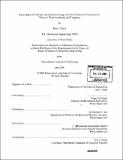| dc.contributor.advisor | Roger D. Kamm. | en_US |
| dc.contributor.author | Mack, Peter J. (Peter Joseph), 1980- | en_US |
| dc.contributor.other | Massachusetts Institute of Technology. Dept. of Mechanical Engineering. | en_US |
| dc.date.accessioned | 2005-09-06T21:51:47Z | |
| dc.date.available | 2005-09-06T21:51:47Z | |
| dc.date.copyright | 2004 | en_US |
| dc.date.issued | 2004 | en_US |
| dc.identifier.uri | http://hdl.handle.net/1721.1/27124 | |
| dc.description | Thesis (S.M.)--Massachusetts Institute of Technology, Dept. of Mechanical Engineering, 2004. | en_US |
| dc.description | Includes bibliographical references (p. 63-66). | en_US |
| dc.description.abstract | Vascular endothelial cells rapidly sense and transduce external forces into biological signals through a process known as mechanotransduction. Numerous biological processes are involved in mechanotransduction, including calcium signaling and activation of focal adhesion sites, but little is known about how cells initially sense changes in the external mechanical environment. In order to examine the rapid mechanosensing thresholds involved with mechanotransduction, calcium concentration changes and focal adhesion site translocations were observed with fluorescent microscopy by labeling intracellular calcium with Fluo-3 calcium dye and by infecting cells with GFP-paxillin fusion proteins. Monitoring calcium concentration changes proved unreliable for determining mechanotransduction thresholds, while a non-graded, time dependent ([similar to] minutes) steady load threshold for mechanotransduction was established between 0.90 and 1.45 nN for focal adhesion site activation. Activation was greatest near the point of forcing (< 7.5 [mu]m), indicating that shear forces imposed on the apical cell membrane transmit non-uniformly to the basal cell surface and that focal adhesion sites may function as individual mechanosensors responding to local levels of force. Results from a while applying nN-level magnetic trap shear forces to the cell apex via integrin-linked magnetic beads. Both biological responses were monitored continuum, viscoelastic finite element model of magnetocytometry that represented experimental focal adhesion attachments provided support for a non-uniform force transmission to basal surface focal adhesion sites. Frequency variation between 0.1 and 50 Hz altered focal adhesion translocation and | en_US |
| dc.description.abstract | (cont.) resulted in a biphasic response minimized at 1.0 Hz. Furthermore, applying the tyrosine kinase inhibitors genistein and PP2, a specific Src family kinase inhibitor, resulted in differential effects on force-induced translocation. These results highlight the mutual importance of force transmission and biochemical signaling in focal adhesion mechanotransduction. | en_US |
| dc.description.statementofresponsibility | by Peter J. Mack. | en_US |
| dc.format.extent | 66 p. | en_US |
| dc.format.extent | 4223125 bytes | |
| dc.format.extent | 4229466 bytes | |
| dc.format.mimetype | application/pdf | |
| dc.format.mimetype | application/pdf | |
| dc.language.iso | en_US | |
| dc.publisher | Massachusetts Institute of Technology | en_US |
| dc.rights | M.I.T. theses are protected by copyright. They may be viewed from this source for any purpose, but reproduction or distribution in any format is prohibited without written permission. See provided URL for inquiries about permission. | en_US |
| dc.rights.uri | http://dspace.mit.edu/handle/1721.1/7582 | |
| dc.subject | Mechanical Engineering. | en_US |
| dc.title | Force-induced calcium concentration change and focal adhesion translocation : effects of force amplitude and frequency | en_US |
| dc.type | Thesis | en_US |
| dc.description.degree | S.M. | en_US |
| dc.contributor.department | Massachusetts Institute of Technology. Department of Mechanical Engineering | |
| dc.identifier.oclc | 56842828 | en_US |
